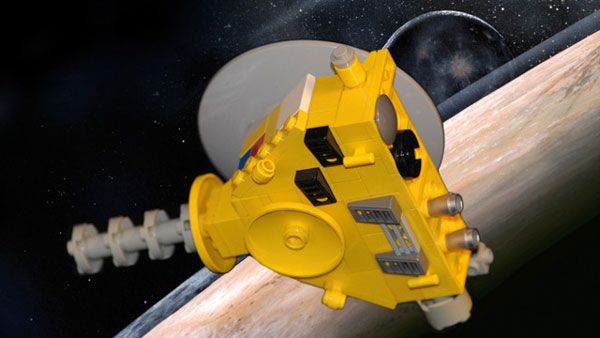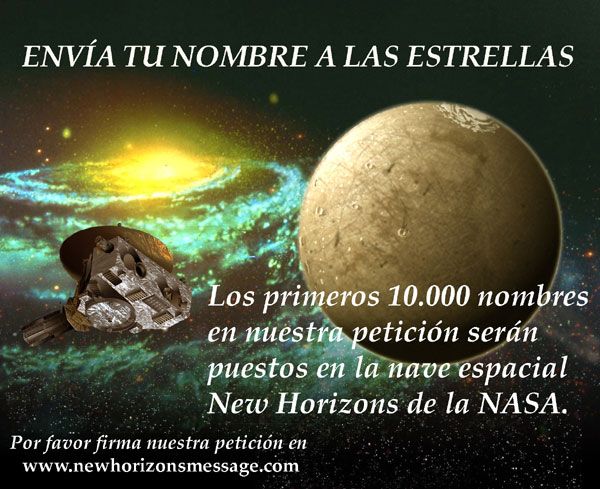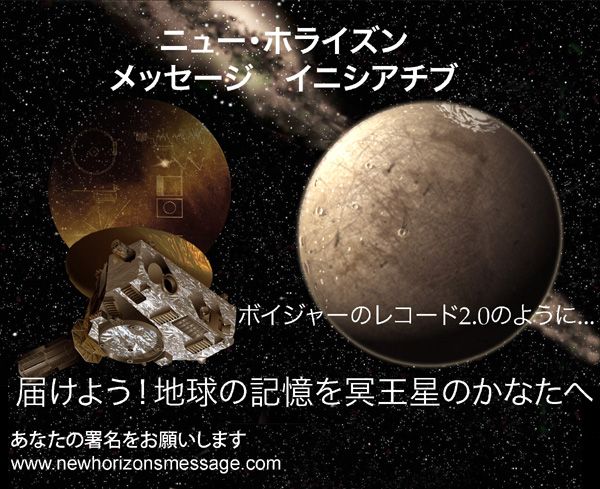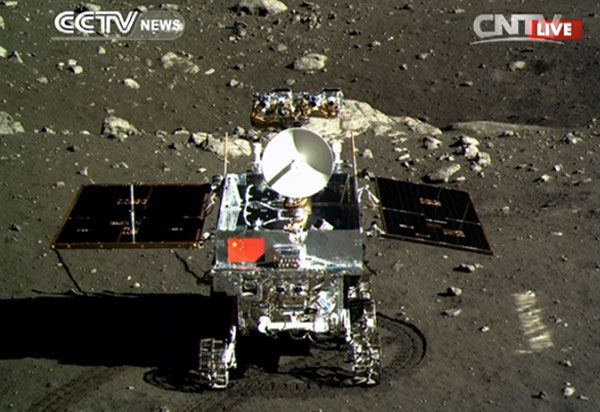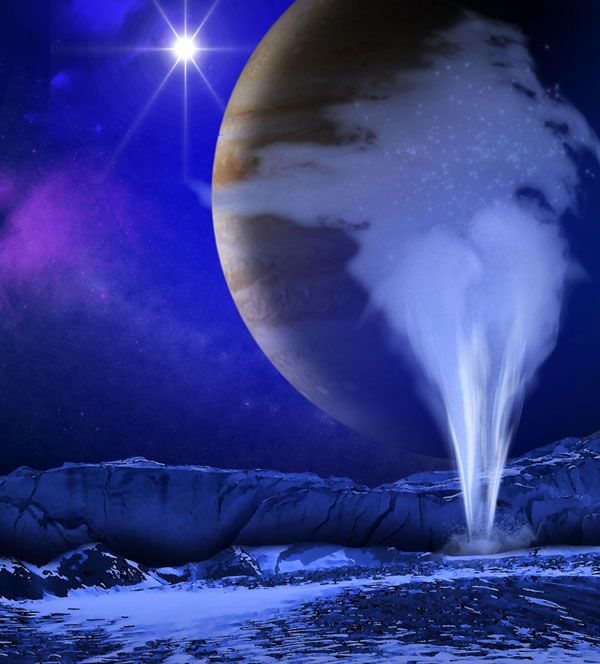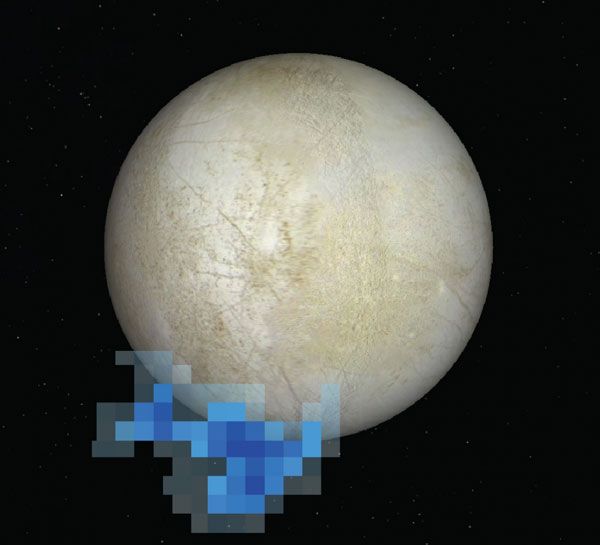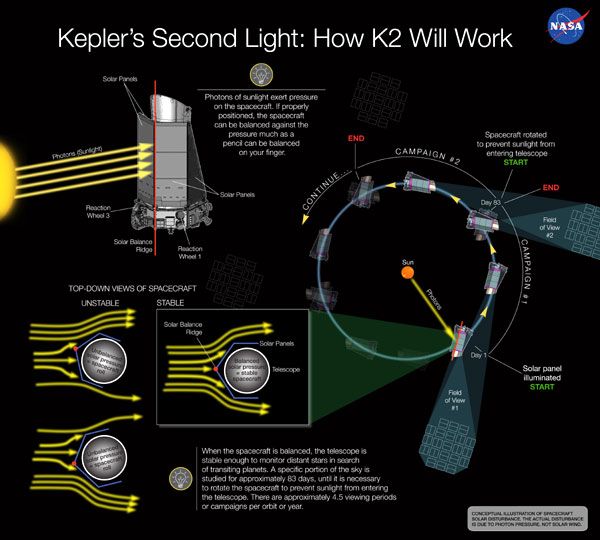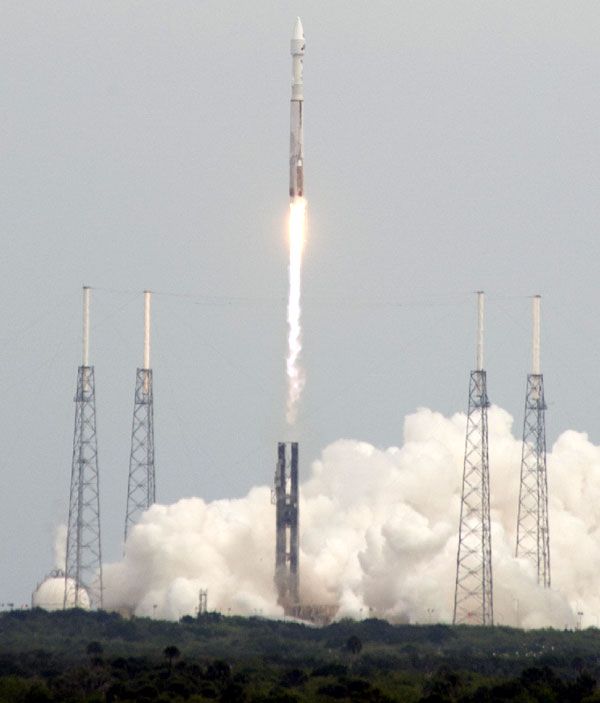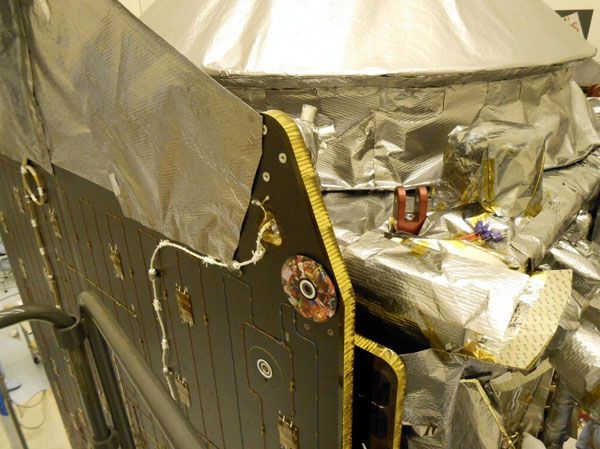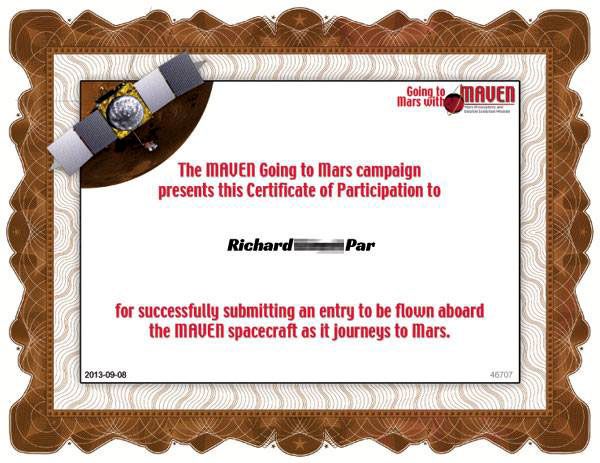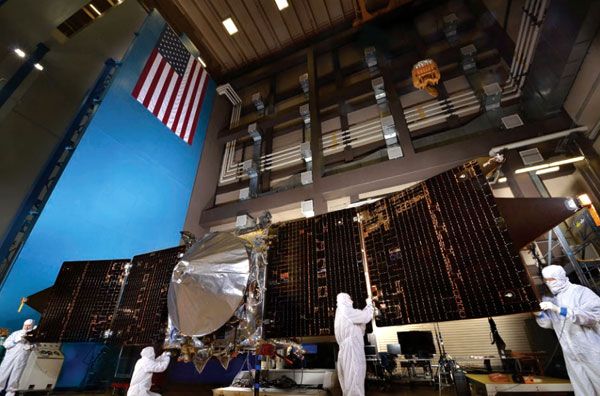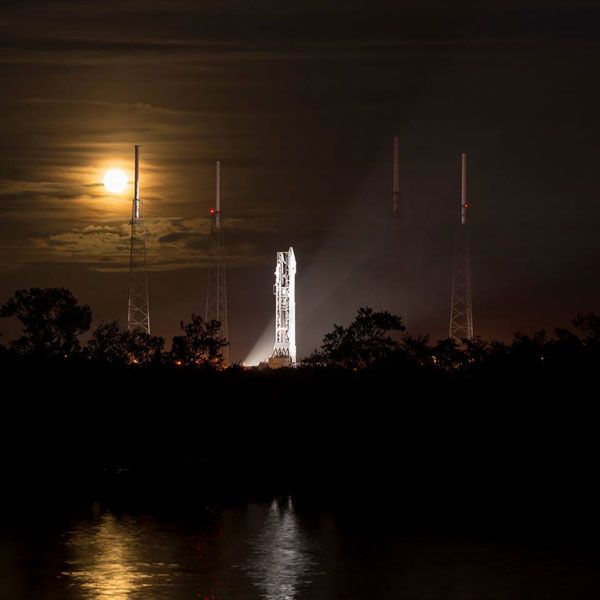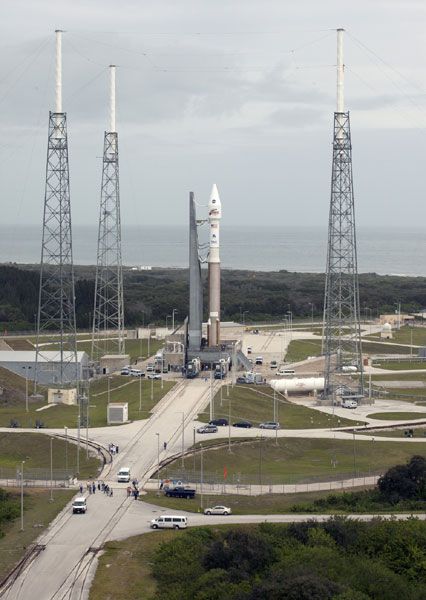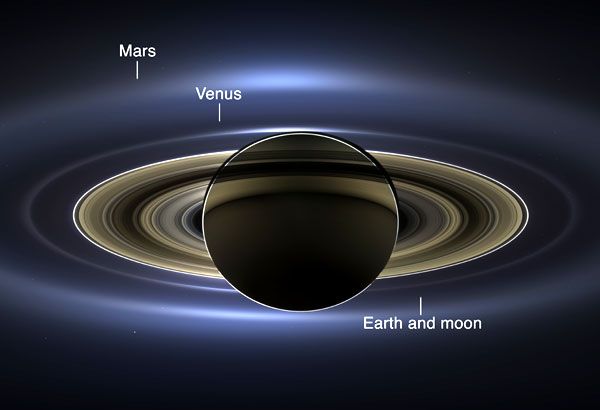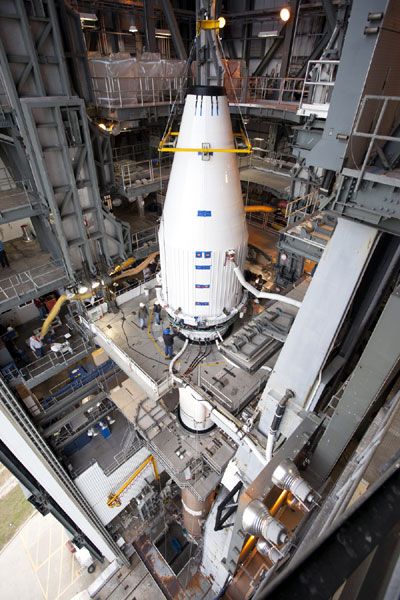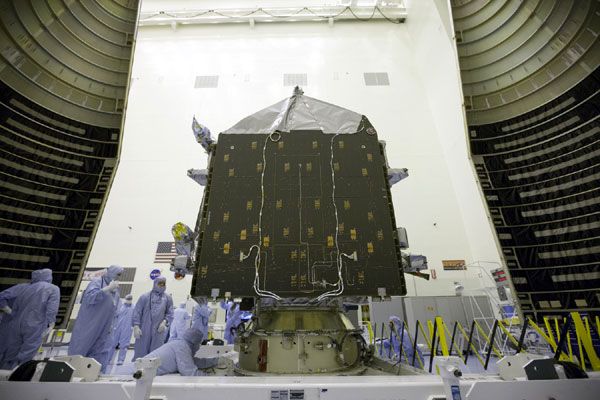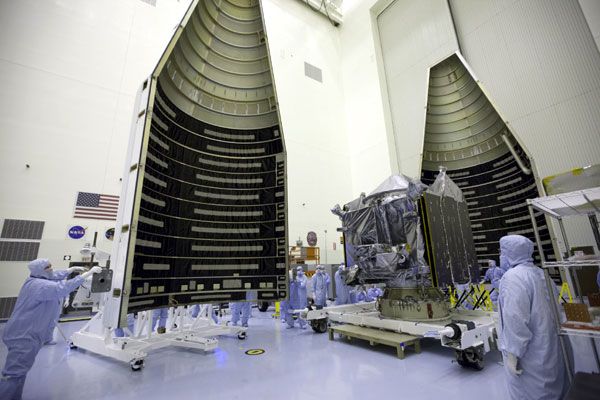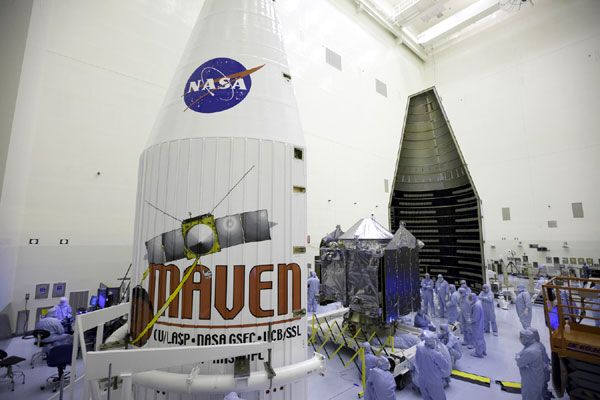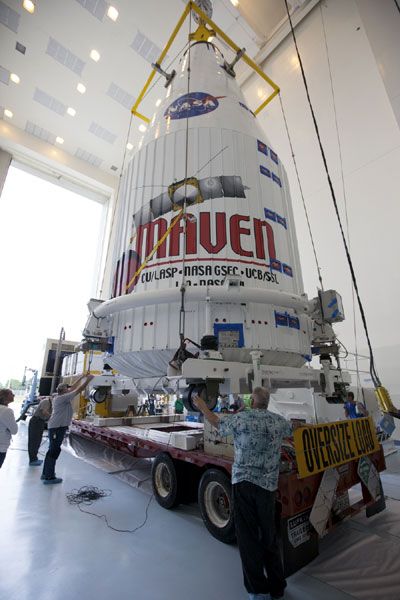 NASA / JPL - Caltech / MSSS
NASA Curiosity: First Mars Age Measurement and Human Exploration Help (Press Release)
NASA / JPL - Caltech / MSSS
NASA Curiosity: First Mars Age Measurement and Human Exploration Help (Press Release)
NASA's
Curiosity rover is providing vital insight about Mars' past and current environments that will aid plans for future robotic and human missions.
In a little more than a year on the Red Planet, the mobile
Mars Science Laboratory has determined the age of a Martian rock, found evidence the planet could have sustained microbial life, taken the first readings of radiation on the surface, and shown how natural erosion could reveal the building blocks of life. Curiosity team members presented these results and more from Curiosity in six papers published online today by
Science Express and in talks at the Fall Meeting of the American Geophysical Union in San Francisco.
The Age of 'Cumberland'
The second rock Curiosity drilled for a sample on Mars, which scientists nicknamed "Cumberland," is the first ever to be dated from an analysis of its mineral ingredients while it sits on another planet. A report by Kenneth Farley of the California Institute of Technology in Pasadena, and co-authors, estimates the age of Cumberland at 3.86 billion to 4.56 billion years old. This is in the range of earlier estimates for rocks in Gale Crater, where Curiosity is working.
"The age is not surprising, but what is surprising is that this method worked using measurements performed on Mars," said Farley. "When you're confirming a new methodology, you don't want the first result to be something unexpected. Our understanding of the antiquity of the Martian surface seems to be right."
The analysis of Cumberland from a sample drilled by Curiosity was a fundamental and unprecedented measurement considered unlikely when the rover landed in 2012. Farley and his co-authors adapted a 60-year-old radiometric method for dating Earth rocks that measures the decay of an isotope of potassium as it slowly changes into argon, an inert gas. Argon escapes when a rock is melted. This dating method measures the amount of argon that accumulates when the rock hardens again.
Before they could measure rocks directly on Mars, scientists estimated their ages by counting and comparing the numbers of impact craters on various areas of the planet. The crater densities are correlated with ages based on comparisons with crater densities on the moon, which were tied to absolute dates after the
Apollo lunar missions returned rocks to Earth.
Farley and co-authors also assessed how long Cumberland has been within about an arm's reach of the Martian surface, where cosmic rays that hit atoms in the rock produce gas buildups that Curiosity can measure.
Analyses of three different gases yielded exposure ages in the range of 60 million to 100 million years. This suggests shielding layers above the rock were stripped away relatively recently. Combined with clues of wind erosion Curiosity observed, the exposure-age discovery points to a pattern of windblown sand chewing away at relatively thick layers of rock. The eroding layer forms a retreating vertical face, or scarp.
"The exposure rate is surprisingly fast," Farley said. "The place where you'll find the rocks with the youngest exposure age will be right next to the downwind scarps."
From Rocks to Building Blocks?
Finding rocks with the youngest exposure age is important in the mission's investigations of whether organic chemicals are preserved from ancient environments. Organic chemicals are building blocks for life, although they also can be produced without any biology.
"We're making progress on the path to determining whether there are Martian organics in there," Doug Ming, of NASA's Johnson Space Center, Houston, said of the Cumberland rock sample. "We detect organics but can't rule out that they might be brought along from Earth." Curiosity detected higher amounts in Cumberland than it did in in either test runs with Martian soil samples or analysis of empty sample cups. Increasing the amount of rock powder in the test cup increased the amount of organic content detected.
Favorable for Life
Ming is the lead author of a new report about a site called "Yellowknife Bay." The team reported 10 months ago that the first rock Curiosity drilled there, nicknamed "John Klein," yielded evidence that met the mission's goal of identifying a Martian environment favorable for microbial life long ago. Yellowknife Bay's clay-rich lakebed habitat offers the key chemical elements for life, plus water not too acidic or salty, and an energy source. The energy source is a type used by many rock-eating microbes on Earth: a mix of sulfur- and iron-containing minerals that are ready acceptors of electrons, and others that are ready electron donors, like the two poles of a battery.
Not only has Curiosity accomplished its primary goal of finding evidence for an ancient environment that could have supported life, but it also has provided evidence habitable conditions existed more recently than expected and likely persisted for millions of years.
Additional new results from Curiosity are providing the first readings of radiation hazards at Mars' surface, which will aid planning of human missions to Mars. Other findings will guide the search for evidence of life on Mars by improving insight about how erosion may expose buried clues of molecular building blocks of life.
New estimates of when habitable conditions existed at Yellowknife Bay and how long they persisted come from details of rocks' composition and layering. It is thought that Mars had enough fresh water to generate clay minerals -- and possibly support life -- more than 4 billion years ago, but that the planet underwent drying that left any remaining liquid water acidic and briny. A key question was whether the clay minerals at Yellowknife Bay formed earlier, upstream on the rim of Gale Crater where the bits of rock originated, or later, downstream where the rock particles were carried by water and deposited.
Scott McLennan of Stony Brook University in Stony Brook, N.Y., and co-authors found that chemical elements in the rocks indicate the particles were carried from their upstream source area to Yellowknife Bay and that most chemical weathering occurred after they were deposited. The loss of elements that leach easily, such as calcium and sodium, would be noticeable if the weathering that turns some volcanic minerals into clay minerals had happened upstream. Scientists did not notice such leaching.
David Vaniman of the Planetary Science Institute in Tucson, Ariz., and co-authors found supporting evidence in a separate mineral analysis of sedimentary rocks at Yellowknife Bay. They noticed a lack of olivine and an abundance of magnetite, which suggests the rocks turned to clay after they washed downstream. The presence of smectite tells about conditions where the clay formed.
"Smectite is the typical clay mineral in lake deposits," Vaniman said. "It is commonly called a swelling clay -- the kind that sticks to your boot when you step in it. You find biologically rich environments where you find smectites on Earth."
John Grotzinger of Caltech and co-authors examined physical characteristics of rock layers in and near Yellowknife Bay and concluded the habitable environment there existed at a time "relatively young by Martian standards." It was a part of Martian history called the Hesperian Era, when parts of the planet were already becoming drier and more acidic, less than 4 billion years ago and roughly the same time as the oldest evidence for life on Earth.
"This habitable environment existed later than many people thought there would be one," Grotzinger said. "This has global implications. It's from a time when there were deltas, alluvial fans and other signs of surface water at many places on Mars, but those were considered too young, or too short-lived, to have formed clay minerals. The thinking was, if they had clay minerals, those must have washed in from older deposits. Now, we know the clay minerals could be produced later, and that gives us many locations that may have had habitable environments, too."
Research suggests habitable conditions in the Yellowknife Bay area may have persisted for millions to tens of millions of years. During that time rivers and lakes probably appeared and disappeared. Even when the surface was dry, the subsurface likely was wet, as indicated by mineral veins deposited by underground water into fractures in the rock. The thickness of observed and inferred tiers of rock layers provides the basis for estimating long duration, and the discovery of a mineral energy source for underground microbes favors habitability throughout.
Implications for Human Explorers
Today's reports include the first measurements of the natural radiation environment on the surface of Mars. Cosmic rays from outside our solar system and energetic particles from the sun bombarded the surface at Gale Crater with an average of 0.67 millisieverts per day from August 2012 to June 2013, according to a report by Don Hassler of Southwest Research Institute in Boulder, Colo., and co-authors. For comparison, radiation exposure from a typical chest X-ray is about 0.02 millisievert. That 10-month measurement period did not include any major solar storms affecting Mars, and more than 95 percent of the total came from cosmic rays.
Results from the surface-radiation monitoring provide an additional piece of the puzzle for projecting the total round-trip radiation dose for a future human mission to Mars. Added to dose rates Curiosity measured during its flight to Mars, the Mars surface results project a total round-trip dose rate for a future human mission at the same period in the solar cycle to be on the order of 1,000 millisieverts.
Long-term population studies have shown exposure to radiation increases a person's lifetime cancer risk. Exposure to a dose of 1,000 millisieverts is associated with a 5 percent increase in risk for developing fatal cancer. NASA's current career limit for increased risk for its astronauts currently operating in low-Earth orbit is 3 percent. The agency is working with the Institute of Medicine of the National Academies to address the ethics, principles and guidelines for health standards for long duration and exploration spaceflight missions.
The radiation detected by Curiosity is consistent with earlier predictions. The new data will help NASA scientists and engineers create better models to anticipate the radiation environment human explorers will face, as the agency develops new technologies to protect astronauts in deep space.
"Our measurements provide crucial information for human missions to Mars," Hassler said. "We're continuing to monitor the radiation environment and seeing the effects of major solar storms on the surface at different times in the solar cycle, will give additional important data. Our measurements also tie into Curiosity's investigations about habitability. The radiation sources that are concerns for human health also affect microbial survival as well as preservation of organic chemicals."
If any organic chemicals that are potential signs of life did exist within rocks at about 2 inches
(5 centimeters), the depth of Curiosity's drill, Hassler estimated they would be depleted up to 1,000-fold in about 650 million years by radiation at the exposure rate measured in Curiosity's first 10 months. However, the Cumberland rock that Curiosity sampled with its drill at Yellowknife Bay had been exposed to cosmic rays' effects for only about 60 million to 100 million years, by Farley's estimate. Researchers calculate that, with such a young exposure age, enough organic material could still be present in Cumberland to be detectable. Even if Mars has never supported life, the planet receives organic molecules delivered by meteorites, which should leave a detectable trace.
NASA's Jet Propulsion Laboratory built Curiosity and manages the mission for NASA's Science Mission Directorate, Washington.
Source: Jet Propulsion Laboratory
****
 NASA / JPL - Caltech / MSSS
NASA / JPL - Caltech / MSSS
